Publications
Culturally sensitive substance abuse intervention for Hispanic and African American adolescents: Empirical examples from the Alcohol Treatment Targeting Adolescents in Need (ATTAIN) project
Culturally sensitive substance abuse intervention for Hispanic and African American adolescents: Empirical examples from the Alcohol Treatment Targeting Adolescents in Need (ATTAIN) project
 Abstract: This study presents preliminary analyses examining the effects of an alcohol and other drug use (AOD) intervention with minority juvenile offenders. Furthermore, the study investigates the impact of cultural factors on baseline AOD use among Hispanic and African American youth, as well as on treatment outcome. Participants were 213 juvenile offenders referred for treatment (mean age = 15.7 years), 97 of whom have completed treatment to date. The intervention was carried out in clinics placed within the neighborhoods in which the participants resided. Intervention Alcohol Treatment Targeting Adolescents in Need (ATTAIN) is a controlled clinical trial evaluating the effectiveness of a brief motivational, cognitive behavioral intervention, guided self-change (GSC). Participants are assigned randomly to the individual format of guided self-change (I-GSC), the family involved format of guided self-Change (F-GSC), choice of one of these two, or a waiting list control condition. Only participants involved in active intervention are included in the present report. Data were collected via structured face-to-face interviews. Alcohol and marijuana use measures were collected using the Time-line Follow-back interview (TLFB). There were significant reductions in alcohol and marijuana use for all ethnic groups from baseline to post-intervention. Cultural factors (discrimination, acculturation, ethnic pride and cultural mistrust) were associated with pre-intervention levels of alcohol and marijuana use. Among Hispanics, pre-intervention level of substance use were higher among foreign-born than US-born youth. Analyses conducted with the US-born Hispanic group showed that ethnic orientation and ethnic pride were associated positively with greater reductions in alcohol use. The intervention provided through ATTAIN appears to be effective with a multi-ethnic population of juvenile delinquents. Cultural factors, such as ethnic orientation and ethnic mistrust, appear to constitute amenability to treatment factors, with US-born Hispanic youth lower in acculturation responding better to the intervention.
Abstract: This study presents preliminary analyses examining the effects of an alcohol and other drug use (AOD) intervention with minority juvenile offenders. Furthermore, the study investigates the impact of cultural factors on baseline AOD use among Hispanic and African American youth, as well as on treatment outcome. Participants were 213 juvenile offenders referred for treatment (mean age = 15.7 years), 97 of whom have completed treatment to date. The intervention was carried out in clinics placed within the neighborhoods in which the participants resided. Intervention Alcohol Treatment Targeting Adolescents in Need (ATTAIN) is a controlled clinical trial evaluating the effectiveness of a brief motivational, cognitive behavioral intervention, guided self-change (GSC). Participants are assigned randomly to the individual format of guided self-change (I-GSC), the family involved format of guided self-Change (F-GSC), choice of one of these two, or a waiting list control condition. Only participants involved in active intervention are included in the present report. Data were collected via structured face-to-face interviews. Alcohol and marijuana use measures were collected using the Time-line Follow-back interview (TLFB). There were significant reductions in alcohol and marijuana use for all ethnic groups from baseline to post-intervention. Cultural factors (discrimination, acculturation, ethnic pride and cultural mistrust) were associated with pre-intervention levels of alcohol and marijuana use. Among Hispanics, pre-intervention level of substance use were higher among foreign-born than US-born youth. Analyses conducted with the US-born Hispanic group showed that ethnic orientation and ethnic pride were associated positively with greater reductions in alcohol use. The intervention provided through ATTAIN appears to be effective with a multi-ethnic population of juvenile delinquents. Cultural factors, such as ethnic orientation and ethnic mistrust, appear to constitute amenability to treatment factors, with US-born Hispanic youth lower in acculturation responding better to the intervention.
Gil, A.G., Wagner, E.F., & Tubman, J.G. (2004). Culturally sensitive substance abuse intervention for Hispanic and African American adolescents: Empirical examples from the Alcohol Treatment Targeting Adolescents in Need (ATTAIN) project. Addiction, 99140-150. doi:10.1111/j.1360-0443.2004.00861.x
Associations between early-adolescent substance use and subsequent young-adult substance use disorders among a multiethnic male sample in South Florida
Associations between early-adolescent substance use and subsequent young-adult substance use disorders among a multiethnic male sample in South Florida
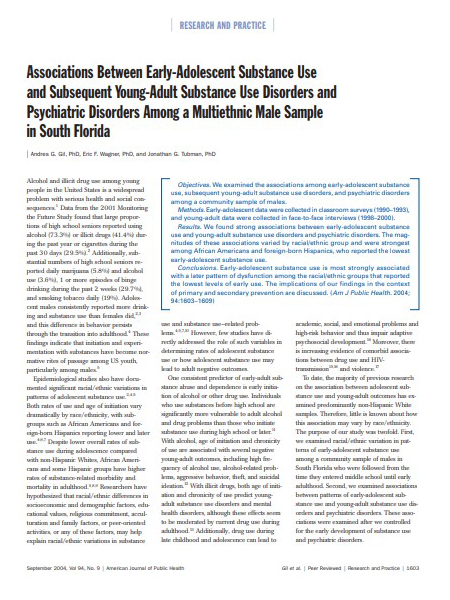 Abstract: We examined the associations among early-adolescent substance use, subsequent young-adult substance use disorders, and psychiatric disorders among a community sample of males. Early-adolescent data were collected in classroom surveys (1990-1993), and young-adult data were collected in face-to-face interviews (1998-2000). We found strong associations between early-adolescent substance use and young-adult substance use disorders and psychiatric disorders. The magnitudes of these associations varied by racial/ethnic group and were strongest among African Americans and foreign-born Hispanics, who reported the lowest early-adolescent substance use. Early-adolescent substance use is most strongly associated with a later pattern of dysfunction among the racial/ethnic groups that reported the lowest levels of early use. The implications of our findings in the context of primary and secondary prevention are discussed.
Abstract: We examined the associations among early-adolescent substance use, subsequent young-adult substance use disorders, and psychiatric disorders among a community sample of males. Early-adolescent data were collected in classroom surveys (1990-1993), and young-adult data were collected in face-to-face interviews (1998-2000). We found strong associations between early-adolescent substance use and young-adult substance use disorders and psychiatric disorders. The magnitudes of these associations varied by racial/ethnic group and were strongest among African Americans and foreign-born Hispanics, who reported the lowest early-adolescent substance use. Early-adolescent substance use is most strongly associated with a later pattern of dysfunction among the racial/ethnic groups that reported the lowest levels of early use. The implications of our findings in the context of primary and secondary prevention are discussed.
Gil, A.G., Wagner, E.F., & Tubman, J.G. (2004). Associations between early-adolescent substance use and subsequent young-adult substance use disorders and psychiatric disorders among a multiethnic male sample in South Florida. American Journal of Public Health, 94(9), 1603-1609. doi:10.2105/AJPH.94.9.1603
Abuse experiences in a community sample of young adults: Relations with psychiatric disorders, sexual risk behaviors, and sexually transmitted diseases
Abuse experiences in a community sample of young adults: Relations with psychiatric disorders, sexual risk behaviors, and sexually transmitted diseases
 Abstract: This study documents significant associations among lifetime abuse experiences, psychiatric diagnoses, and sexual risk behaviors in a multiethnic community sample of young men and women (N = 1803) in South Florida. Self-report data were collected via structured interviews as part of a longitudinal follow-up of a larger school-based study. Participants were grouped according to extent of lifetime abuse experiences. Cumulative lifetime abuse experiences were associated with increased risk for a broad range of individual lifetime psychiatric disorders, as well as cumulative lifetime psychiatric disorders. Both cumulative abuse experiences and cumulative psychiatric disorders were independently associated with (a) higher levels of sexual risk behaviors and (b) higher risk for lifetime sexually transmitted diseases (STDs). Implications for selective prevention of sexual risk behaviors and STDs among young adults with histories of abuse and psychiatric disorders are discussed.
Abstract: This study documents significant associations among lifetime abuse experiences, psychiatric diagnoses, and sexual risk behaviors in a multiethnic community sample of young men and women (N = 1803) in South Florida. Self-report data were collected via structured interviews as part of a longitudinal follow-up of a larger school-based study. Participants were grouped according to extent of lifetime abuse experiences. Cumulative lifetime abuse experiences were associated with increased risk for a broad range of individual lifetime psychiatric disorders, as well as cumulative lifetime psychiatric disorders. Both cumulative abuse experiences and cumulative psychiatric disorders were independently associated with (a) higher levels of sexual risk behaviors and (b) higher risk for lifetime sexually transmitted diseases (STDs). Implications for selective prevention of sexual risk behaviors and STDs among young adults with histories of abuse and psychiatric disorders are discussed.
Tubman, J.G., Montgomery, M.J., Gil, A.G., & Wagner, E.F. (2004). Abuse experiences in a community sample of young adults: Relations with psychiatric disorders, sexual risk behaviors, and sexually transmitted diseases. American Journal of Community Psychology, 34(1/2), 147-162. doi:10.1023/B:AJCP.0000040152.49163.58
Co-occurring substance use and delinquent behavior during early adolescence: Emerging relations and implications for intervention strategies
Co-occurring substance use and delinquent behavior during early adolescence: Emerging relations and implications for intervention strategies
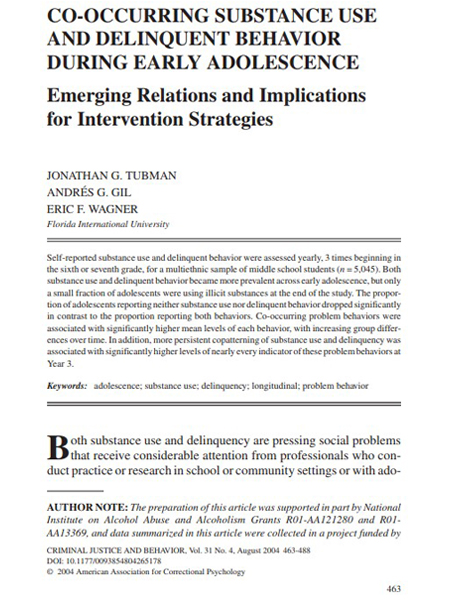 Abstract: Self-reported substance use and delinquent behavior were assessed yearly, 3 times beginning in the sixth or seventh grade, for a multiethnic sample of middle school students (n= 5,045). Both substance use and delinquent behavior became more prevalent across early adolescence, but only a small fraction of adolescents were using illicit substances at the end of the study. The proportion of adolescents reporting neither substance use nor delinquent behavior dropped significantly in contrast to the proportion reporting both behaviors. Co-occurring problem behaviors were associated with significantly higher mean levels of each behavior, with increasing group differences over time. In addition, more persistent copatterning of substance use and delinquency was associated with significantly higher levels of nearly every indicator of these problem behaviors at Year 3.
Abstract: Self-reported substance use and delinquent behavior were assessed yearly, 3 times beginning in the sixth or seventh grade, for a multiethnic sample of middle school students (n= 5,045). Both substance use and delinquent behavior became more prevalent across early adolescence, but only a small fraction of adolescents were using illicit substances at the end of the study. The proportion of adolescents reporting neither substance use nor delinquent behavior dropped significantly in contrast to the proportion reporting both behaviors. Co-occurring problem behaviors were associated with significantly higher mean levels of each behavior, with increasing group differences over time. In addition, more persistent copatterning of substance use and delinquency was associated with significantly higher levels of nearly every indicator of these problem behaviors at Year 3.
Tubman, J.G., Gil, A.G., & Wagner, E.F. (2004). Co-occurring substance use and delinquent behavior during early adolescence. Criminal Justice and Behavior, 31(4), 463-488. doi:10.1177/0093854804265178
Introduction – Special series, current perspectives on implicit cognitive processing in clinical disorders: Implications for assessment and intervention
Introduction – Special series, current perspectives on implicit cognitive processing in clinical disorders: Implications for assessment and intervention
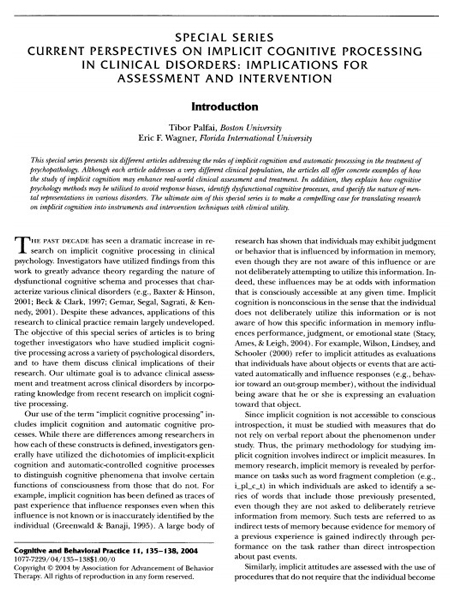 Abstract: This special series presents six different articles addressing the roles of implicit cognition and automatic processing in the treatment of psychopathology. Although each article addresses a very different clinical population, the articles all offer concrete examples of how the study of implicit cognition may enhance real-world clinical assessment and treatment. In addition, they explain how cognitive psychology methods may be utilized to avoid response biases, identify dysfunctional cognitive processes, and specify the nature of mental representations in various disorders. The ultimate aim of this special series is to make a compelling case for translating research on implicit cognition into instruments and intervention techniques with clinical utility.
Abstract: This special series presents six different articles addressing the roles of implicit cognition and automatic processing in the treatment of psychopathology. Although each article addresses a very different clinical population, the articles all offer concrete examples of how the study of implicit cognition may enhance real-world clinical assessment and treatment. In addition, they explain how cognitive psychology methods may be utilized to avoid response biases, identify dysfunctional cognitive processes, and specify the nature of mental representations in various disorders. The ultimate aim of this special series is to make a compelling case for translating research on implicit cognition into instruments and intervention techniques with clinical utility.
Palfai, T., & Wagner, E.F. (2004). Introduction-Special series, current perspectives on implicit cognitive processing in clinical disorders: Implications for assessment and intervention. Cognitive and Behavioral Practice, 11(2), 135-138. doi:10.1016/s1077-7229(04)80024-5
Tobacco Use Prevention Education (TUPE) programs in the State of Florida: Correlates and predictors of teachers’ perceptions of program effectiveness
Tobacco Use Prevention Education (TUPE) programs in the State of Florida: Correlates and predictors of teachers’ perceptions of program effectiveness
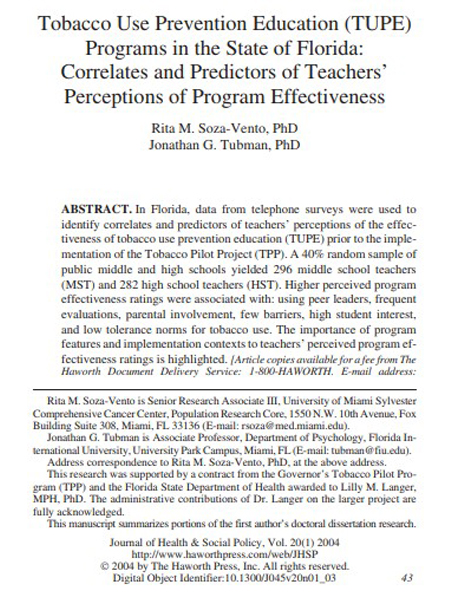 Abstract: In Florida, data from telephone surveys were used to identify correlates and predictors of teachers’ perceptions of the effectiveness of tobacco use prevention education (TUPE) prior to the implementation of the Tobacco Pilot Project (TPP). A 40% random sample of public middle and high schools yielded 296 middle school teachers (MST) and 282 high school teachers (HST). Higher perceived program effectiveness ratings were associated with: using peer leaders, frequent evaluations, parental involvement, few barriers, high student interest, and low tolerance norms for tobacco use. The importance of program features and implementation contexts to teachers’ perceived program effectiveness ratings is highlighted.
Abstract: In Florida, data from telephone surveys were used to identify correlates and predictors of teachers’ perceptions of the effectiveness of tobacco use prevention education (TUPE) prior to the implementation of the Tobacco Pilot Project (TPP). A 40% random sample of public middle and high schools yielded 296 middle school teachers (MST) and 282 high school teachers (HST). Higher perceived program effectiveness ratings were associated with: using peer leaders, frequent evaluations, parental involvement, few barriers, high student interest, and low tolerance norms for tobacco use. The importance of program features and implementation contexts to teachers’ perceived program effectiveness ratings is highlighted.
Soza-Vento, R.M., & Tubman, J.G. (2004). Tobacco Use Prevention Education (TUPE) programs in the State of Florida: Correlates and predictors of teachers’ perceptions of program effectiveness. Journal of Health & Social Policy, 20(1), 43-63. doi:10.1300/J045v20n01_03
Patterns of sexual risk behaviors and psychiatric disorders in a community sample of young adults
Patterns of sexual risk behaviors and psychiatric disorders in a community sample of young adults
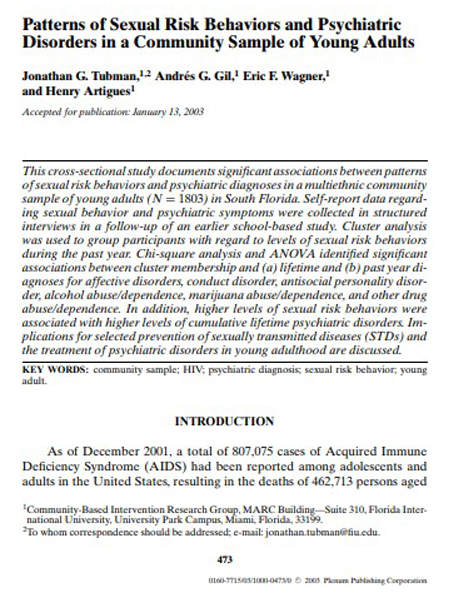 Abstract: This cross-sectional study documents significant associations between patterns of sexual risk behaviors and psychiatric diagnoses in a multiethnic community sample of young adults (N = 1803) in South Florida. Self-report data regarding sexual behavior and psychiatric symptoms were collected in structured interviews in a follow-up of an earlier school-based study. Cluster analysis was used to group participants with regard to levels of sexual risk behaviors during the past year. Chi-square analysis and ANOVA identified significant associations between cluster membership and (a) lifetime and (b) past year diagnoses for affective disorders, conduct disorder, antisocial personality disorder, alcohol abuse/dependence, marijuana abuse/dependence, and other drug abuse/dependence. In addition, higher levels of sexual risk behaviors were associated with higher levels of cumulative lifetime psychiatric disorders. Implications for selected prevention of sexually transmitted diseases (STDs) and the treatment of psychiatric disorders in young adulthood are discussed.
Abstract: This cross-sectional study documents significant associations between patterns of sexual risk behaviors and psychiatric diagnoses in a multiethnic community sample of young adults (N = 1803) in South Florida. Self-report data regarding sexual behavior and psychiatric symptoms were collected in structured interviews in a follow-up of an earlier school-based study. Cluster analysis was used to group participants with regard to levels of sexual risk behaviors during the past year. Chi-square analysis and ANOVA identified significant associations between cluster membership and (a) lifetime and (b) past year diagnoses for affective disorders, conduct disorder, antisocial personality disorder, alcohol abuse/dependence, marijuana abuse/dependence, and other drug abuse/dependence. In addition, higher levels of sexual risk behaviors were associated with higher levels of cumulative lifetime psychiatric disorders. Implications for selected prevention of sexually transmitted diseases (STDs) and the treatment of psychiatric disorders in young adulthood are discussed.
Tubman, J.G., Gil, A.G., Wagner, E.F., & Artigues, H. (2003). Patterns of sexual risk behaviors and psychiatric disorders in a community sample of young adults. Journal of Behavioral Medicine, 26(5), 473. doi:10.1023/A:1025776102574
Conceptualizing alcohol treatment research for Hispanic/Latino adolescents
Conceptualizing alcohol treatment research for Hispanic/Latino adolescents
 Abstract: This paper briefly reviews the Community-Based Intervention Research Group’s ongoing efforts in conceptualizing alcohol treatment research for Hispanic/Latino adolescents. I begin by defining Empirically Supported Therapies (ESTs), Developmentally Sensitive Therapies (DSTs), and Culturally Sensitive Therapies (DSTs). I then argue that these three perspectives need to be integrated for the field to advance. Next, I discuss the complexities inherent in the integration of EST, DST, and CST, and suggest a ‘flexible core approach’ may be the most feasible and promising approach to integration. Finally, I introduce the concept of ‘amenability to treatment’ and describe how it may be applied to understanding how race/ethnicity-related variables may influence response to treatment.
Abstract: This paper briefly reviews the Community-Based Intervention Research Group’s ongoing efforts in conceptualizing alcohol treatment research for Hispanic/Latino adolescents. I begin by defining Empirically Supported Therapies (ESTs), Developmentally Sensitive Therapies (DSTs), and Culturally Sensitive Therapies (DSTs). I then argue that these three perspectives need to be integrated for the field to advance. Next, I discuss the complexities inherent in the integration of EST, DST, and CST, and suggest a ‘flexible core approach’ may be the most feasible and promising approach to integration. Finally, I introduce the concept of ‘amenability to treatment’ and describe how it may be applied to understanding how race/ethnicity-related variables may influence response to treatment.
Wagner, E.F. (2003). Conceptualizing alcohol treatment research for Hispanic/Latino adolescents. Alcoholism: Clinical & Experimental Research, 27(8), 1349-1352. doi:10.1097/01.alc.0000080201.46747.d5
The effects of assessment feedback on rapport-building and self-enhancement processes
The effects of assessment feedback on rapport-building and self-enhancement processes
 Abstract: An experiment was conducted to test the effects of assessment feedback on rapport and self-enhancement. After adult participants (N = 83) completed the Millon Index of Personality Styles, the experimental group was given personalized assessment feedback; the control group received only general information about the inventory. After the session, all rapport-related scores (positive evaluations of examiner and session) and most of the self-enhancement-related scores (accurate mirroring, self-esteem, self-competence, and self-understanding) were significantly higher in the group that received assessment feedback. These results suggest that both processes are mechanisms by which the provision of assessment feedback produces positive change. Implications for mental health counselors are drawn.
Abstract: An experiment was conducted to test the effects of assessment feedback on rapport and self-enhancement. After adult participants (N = 83) completed the Millon Index of Personality Styles, the experimental group was given personalized assessment feedback; the control group received only general information about the inventory. After the session, all rapport-related scores (positive evaluations of examiner and session) and most of the self-enhancement-related scores (accurate mirroring, self-esteem, self-competence, and self-understanding) were significantly higher in the group that received assessment feedback. These results suggest that both processes are mechanisms by which the provision of assessment feedback produces positive change. Implications for mental health counselors are drawn.
Allen, A., Montgomery, M., Tubman, J., Frazier, L., & Escovar, L. (2003). The effects of assessment feedback on rapport-building and self-enhancement processes. Journal of Mental Health Counseling,25(3), 165-182. doi:10.17744/mehc.25.3.lw7h84q861dw6ytj
Harm reduction: A social work practice model and social justice agenda
Harm reduction: A social work practice model and social justice agenda
 Abstract: Efforts in the United States to eradicate drug use through supply reduction (that is, the War on Drugs) have increasingly violated the principles of social justice and human rights, both locally and globally. This has created ethical conflicts for social workers in policy making, practice, and research. Harm reduction has been conceptualized as a peace movement and is aligned with the humanistic values around which social work is organized. The authors examine how social workers may reduce the ethical conflicts associated with efforts to address substance abuse by adopting a harm reduction approach to policy, practice, and research. They examine current drug policies, the consequences of the policies, and, in particular, how the policies affect social workers as practitioners, agents of social control, and guardians of social justice.
Abstract: Efforts in the United States to eradicate drug use through supply reduction (that is, the War on Drugs) have increasingly violated the principles of social justice and human rights, both locally and globally. This has created ethical conflicts for social workers in policy making, practice, and research. Harm reduction has been conceptualized as a peace movement and is aligned with the humanistic values around which social work is organized. The authors examine how social workers may reduce the ethical conflicts associated with efforts to address substance abuse by adopting a harm reduction approach to policy, practice, and research. They examine current drug policies, the consequences of the policies, and, in particular, how the policies affect social workers as practitioners, agents of social control, and guardians of social justice.
Brocato, J., & Wagner, E.F. (2003). Harm reduction: A social work practice model and social justice agenda. Health & Social Work, 28(2), 117-125. doi:10.1093/hsw/28.2.117
